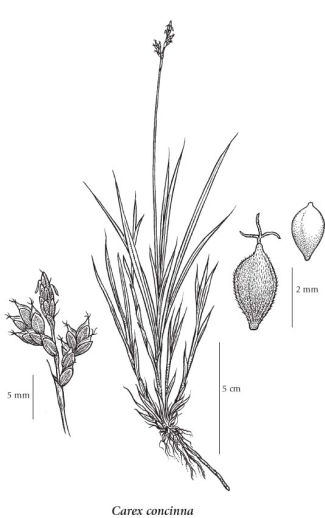Carex concinna R. Br.
low northern sedge
Cyperaceae (Sedge family)
Introduction to Vascular Plants
low northern sedge
Cyperaceae (Sedge family)
Introduction to Vascular Plants
Species Information
General:
Perennial, loosely tufted herb from slender, scaly rhizomes; stems 5-15 (20) cm tall, usually much longer than the leaves.
Leaves:
Sheaths light brown, the lower ones bladeless and thread-like; blades 5 to 9 per stem, flat, the margins rolled-under, gradually tapering to the tips, 1-3 mm wide.
Flowers:
Spikes 3 or 4, the terminal one lanceolate, 3-7 mm long, with male flowers, the lower 2 or 3 spikes shortly cylindrical, 4-8 mm long, unstalked or short-stalked, with female flowers, erect; bracts subtending the female spikes reduced to bladeless sheaths, 1 cm long or less.
Fruits:
Perigynia broadly egg-shaped, 3-3.5 mm long, 1-1.3 mm wide, pale greenish or straw-coloured, 3-angled, stiff-hairy, 2-ribbed and several-nerved, 5 to 12, crowded, erect, short-stalked, the beaks 0.3-0.7 mm long, bidentate; female scales broadly egg-shaped, brown, with translucent margins, much shorter than the perigynia; stigmas 3; achenes 3-angled, 1.4-2 mm long.
Illustration

If more than one illustration is available for a species (e.g., separate illustrations were provided for two subspecies) then links to the separate images will be provided below. Note that individual subspecies or varietal illustrations are not always available.
Illustration Source: The Illustrated Flora of British Columbia
Ecology
Ecological Framework for Carex concinna
The table below shows the species-specific information calculated from
original data (BEC database) provided by the BC Ministry of Forests and Range.
(Updated August, 2013)
The table below shows the species-specific information calculated from
original data (BEC database) provided by the BC Ministry of Forests and Range.
(Updated August, 2013)
| Site Information |
Value / Class |
||
|
Avg |
Min |
Max |
|
| Elevation
(metres) |
1210 | 16 | 2440 |
| Slope
Gradient (%) |
21 | 0 | 173 |
|
Aspect (degrees) |
244 | 0 | 360 |
| Soil
Moisture Regime (SMR) [0 - very xeric; 4 - mesic; 8 - hydric] |
3 | 0 | 7 |
| Modal
Nutrient Regime
Class |
C | ||
| #
of field plots species was recorded in: |
502 | ||
| Modal
BEC Zone Class |
IDF | ||
|
All BEC Zones (# of stations/zone) species was recorded in |
BAFA(3), BG(1), BWBS(64), ESSF(85), ICH(27), IDF(120), MS(67), PP(3), SBPS(34), SBS(21), SWB(19) | ||
|
Source:
Klinkenberg 2013
|
|||